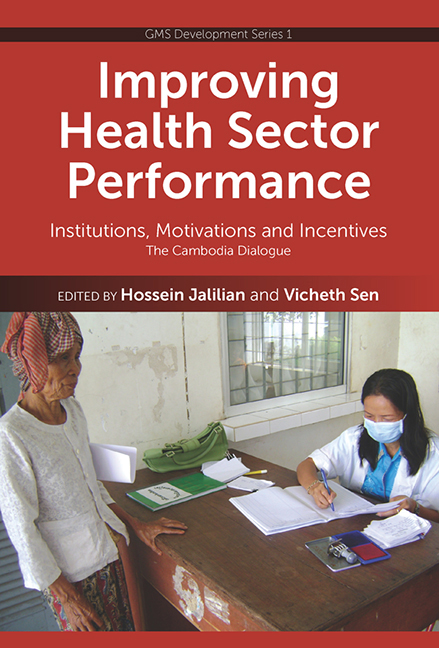 Improving Health Sector Performance
Improving Health Sector Performance from Part III - Optimal Health Workers Contracts
Published online by Cambridge University Press: 21 October 2015
BACKGROUND
Brief Overview of Cambodia's Health Service System
In Cambodia, health centres and health posts, mainly located in rural areas and providing the minimum package of activities (MPA), are the first point of patient contact. These facilities are staffed by nurses and midwives and do not normally include doctors, except in the case of former district hospitals. The health post is the lowest level of facility and is usually served by one or two staff.
The next facility level are the referral hospitals, which are classified according to their capacity to provide the Complementary Package of Activities (CPA). Although their staffing includes full-time doctors, CPA 1 hospitals do not have general anaesthesia surgery. CPA 2 hospitals have general anaesthesia surgery, and CPA 3 hospitals, the highest level, usually located in provincial centres, offer additional specialized services. In 2003, fifteen referral hospitals were classed as CPA 3 (MoH 2006a).
The five MoH national hospitals top the hierarchy of government health care facilities. All are located in Phnom Penh and offer a range of specialized tertiary services. Three private non-profit hospitals, which are members of the Kantha Bopha Group, are also included in official statistics as “national hospitals”. Of those, two are in Phnom Penh and another one is in Siem Riep.
The Ministry of Health plans to increase the number of operational districts and health facilities to enhance the accessibility of care (MoH 2008).
The private health sector has grown substantially since 1993, and there are now more for-profit than public facilities in Cambodia. Recently, two private hospitals have been established in Phnom Penh. In addition, there are many different types of agencies within the private health sector, ranging from medical clinics (without beds) to polyclinics equipped with high-technology equipment. There are 2,457 medical clinics without beds and 274 with beds. Accounting for only 9.5 per cent of the country's population, Phnom Penh harbours a disproportionate share of private facilities (Table 9.1).
Four paediatric, private, non-profit hospitals are managed and funded outside the government sector. Additionally, the Centre for Hope Hospital operates virtually entirely outside the Ministry of Health. Some NGOs, such as the Reproductive Health Association of Cambodia and Reproductive and Child Health Alliance, also run health clinics, particularly in reproductive health care.
To save this book to your Kindle, first ensure no-reply@cambridge.org is added to your Approved Personal Document E-mail List under your Personal Document Settings on the Manage Your Content and Devices page of your Amazon account. Then enter the ‘name’ part of your Kindle email address below. Find out more about saving to your Kindle.
Note you can select to save to either the @free.kindle.com or @kindle.com variations. ‘@free.kindle.com’ emails are free but can only be saved to your device when it is connected to wi-fi. ‘@kindle.com’ emails can be delivered even when you are not connected to wi-fi, but note that service fees apply.
Find out more about the Kindle Personal Document Service.
To save content items to your account, please confirm that you agree to abide by our usage policies. If this is the first time you use this feature, you will be asked to authorise Cambridge Core to connect with your account. Find out more about saving content to Dropbox.
To save content items to your account, please confirm that you agree to abide by our usage policies. If this is the first time you use this feature, you will be asked to authorise Cambridge Core to connect with your account. Find out more about saving content to Google Drive.